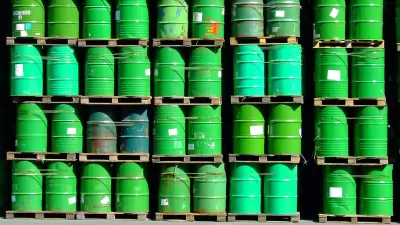The hazards of shipping North Dakotan crude-by-rail have been well documented and are the focus of new DOT regulations due to its volatility, but there's a more positive side to this oil and the trains that deliver it, illustrated in Philadelphia.
We recently reported on demonstrations in California at a Bay Area facility that would store oil from North Dakota that would be delivered by rail.
In Philadelphia, the report [listen here] by Katie Colaneri of Philadelphia's WHYY public radio station includes a celebration from last fall as the first oil unit train arrives from North Dakota at a huge refinery carrying the same volatile crude that has stirred the fears of Pittsburg, Calif. residents.
Why the different receptions to crude-by-rail from the Bakken shale formation? In Philadelphia, the combination of cheap Bakken crude and oil unit trains means that an aging oil refinery will not have to close. "Hundreds of workers were getting pink slips," states Colaneri.
Last fall, workers in blue jumpsuits applauded as a train hauling 120 black tanker cars full of crude oil from North Dakota pulled into the 140-year-old refinery complex in South Philadelphia.
Today, the Philadelphia Energy Solutions refinery is the single-largest consumer of North Dakota crude oil [and also "the largest oil refining complex on the U.S. Eastern seaboard", according to its website.]
However, energy analyst Kevin Lindemer with the firm IHS, tells Colaneri that pipelines would be preferable to oil trains.
Without pipelines to move it underground, increased traffic on the rails has resulted in more derailments across the country. In January, a derailment in Philadelphia left six tanker cars full of oil intact, but leaning across the tracks of a bridge that spans [the Schuylkill River] and a busy interstate.
In addition to pipelines to replace oil trains, natural gas pipelines are needed to access Pennsylvania's abundant natural gas from the Marcellus Shale, states the refinery's CEO, Phil Rinaldi, which "would revitalize the entire region...by build(ing) a dynamic, manufacturing-based economy."
Lindemer agrees. What's holding back the region is infrastructure, he emphasizes. And infrastructure means energy pipelines.
FULL STORY: Philadelphia Capitalizes On Energy Boom

Alabama: Trump Terminates Settlements for Black Communities Harmed By Raw Sewage
Trump deemed the landmark civil rights agreement “illegal DEI and environmental justice policy.”

Study: Maui’s Plan to Convert Vacation Rentals to Long-Term Housing Could Cause Nearly $1 Billion Economic Loss
The plan would reduce visitor accommodation by 25% resulting in 1,900 jobs lost.

Why Should We Subsidize Public Transportation?
Many public transit agencies face financial stress due to rising costs, declining fare revenue, and declining subsidies. Transit advocates must provide a strong business case for increasing public transit funding.

Paris Bike Boom Leads to Steep Drop in Air Pollution
The French city’s air quality has improved dramatically in the past 20 years, coinciding with a growth in cycling.

Why Housing Costs More to Build in California Than in Texas
Hard costs like labor and materials combined with ‘soft’ costs such as permitting make building in the San Francisco Bay Area almost three times as costly as in Texas cities.

San Diego County Sees a Rise in Urban Coyotes
San Diego County experiences a rise in urban coyotes, as sightings become prevalent throughout its urban neighbourhoods and surrounding areas.
Urban Design for Planners 1: Software Tools
This six-course series explores essential urban design concepts using open source software and equips planners with the tools they need to participate fully in the urban design process.
Planning for Universal Design
Learn the tools for implementing Universal Design in planning regulations.
Smith Gee Studio
Alamo Area Metropolitan Planning Organization
City of Santa Clarita
Institute for Housing and Urban Development Studies (IHS)
City of Grandview
Harvard GSD Executive Education
Toledo-Lucas County Plan Commissions
Salt Lake City
NYU Wagner Graduate School of Public Service



























